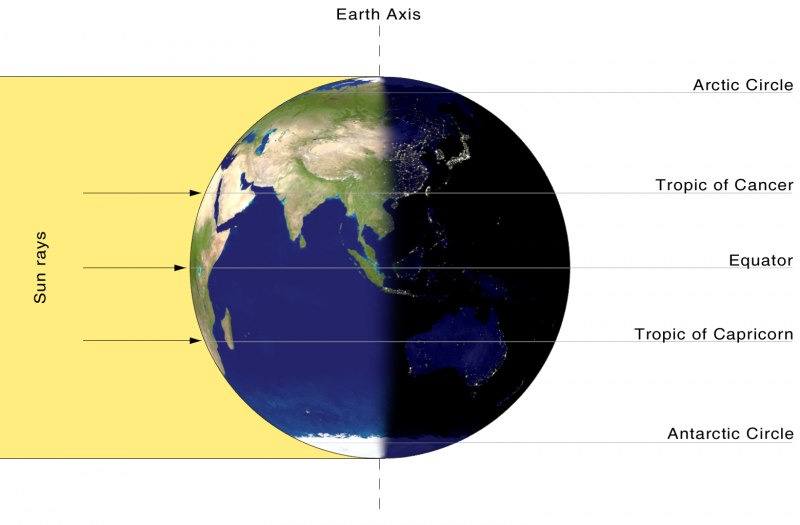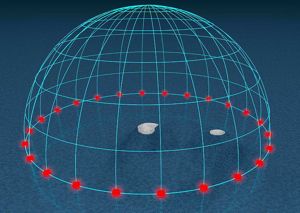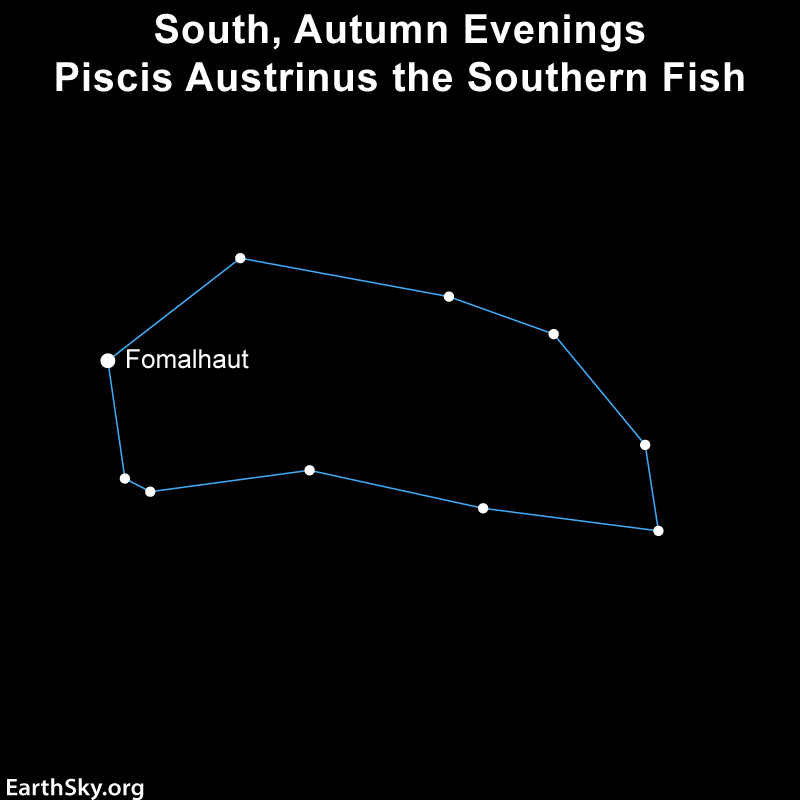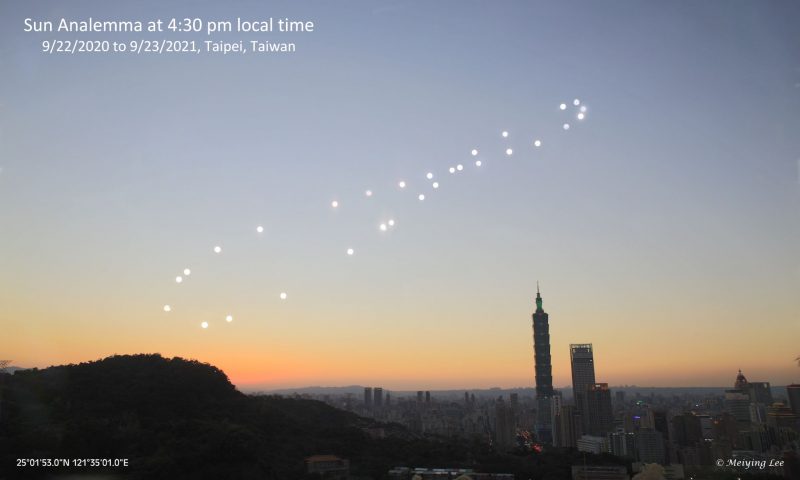Happy equinox! We celebrate the September equinox as the first day of autumn for the Northern Hemisphere, and the first day of spring for the Southern Hemisphere. Watch a video about the September equinox, above.
The September equinox is a seasonal milestone in Earth’s yearly orbit around the sun. At an equinox, the sun appears directly above Earth’s equator. At the September equinox, the sun is moving from north to south as it crosses above the equator. It’s bringing summer to the Southern Hemisphere and winter to the Northern Hemisphere.
The 2024 September equinox will fall at 12:44 UTC (7:44 a.m. CDT) on September 22, 2024. On this day, days and nights are approximately (but not exactly) equal in length for everyone across the globe. The word equinox comes from the Latin aequus (equal) and nox (night), that is, equal night.
Keep reading to learn more about this important day.

Earth’s tilt causes it
The earliest humans spent more time outside than we do. They used the sky as both a clock and a calendar. And they could easily see that the sun’s path across the sky, the length of daylight and the location of the sunrise and sunset all shift in a regular way throughout the year.
The equinoxes and solstices happen because Earth tilts on its axis by 23 1/2 degrees. Because of the Earth’s tilt, the Northern and Southern Hemispheres trade places in receiving the sun’s light and warmth most directly. The solstices indicate our greatest (or least) tilt toward the sun, in either hemisphere. The equinoxes fall midway between the solstices.
Earth’s two hemispheres receive the sun’s rays about equally around equinox time. But Earth never stops moving in orbit around the sun. And these days of approximately equal daylight and night will change quickly as we move toward the December solstice. Maybe you’ve noticed that? The length of daylight changes more quickly from day to day around the equinoxes than around the time of the solstices.

A good day to find due east and due west
The day of an equinox is a good day for finding the directions due east and due west from your favorite place to watch the sky. The sun rises due east and sets due west at the equinoxes. It’s true no matter where you live on Earth. Why? Because we all see the same sky.
Everywhere on Earth, except at the North and South Poles, you have a due east and due west point on your horizon. And each point marks the intersection of your horizon with the celestial equator, the imaginary line above the true equator of the Earth.
At the equinoxes, the sun appears overhead at local solar noon as seen from Earth’s equator, as the illustration below shows. The sun is on the celestial equator. The celestial equator intersects due east and due west for everyone around the globe. So the sun rises and sets due east and due west at the equinox.
So go outside around sunset or sunrise on the day of an equinox. Notice the location of the sun on the horizon with respect to familiar landmarks. If you do this, you’ll be able to use those landmarks to find those cardinal directions in the weeks and months ahead, long after Earth has moved on in its ceaseless orbit around the sun.

Signs of the September equinox in nature
The signs that summer is gone – and winter is coming – are everywhere now on the northern half of Earth’s globe. In the Northern Hemisphere, dawn comes later, and sunset earlier. Also, notice the arc of the sun across the sky. It’s shifting southward now. And birds and butterflies are migrating south, along with the path of the sun.
The shorter days are bringing cooler weather. A chill is in the air. In New York City and other fashionable places, some people have stopped wearing white. Creatures of the wild are putting on their winter coats.
All around us, trees and plants are ending this year’s cycle of growth. Perhaps they’re responding with glorious autumn leaves, or a last burst of bloom before winter comes.
In the night sky, Fomalhaut – our Autumn Star – is making its way across the heavens each night.


September equinox images from EarthSky’s community



Equinoxes and Earth’s seasons

Bottom line: The September equinox is here! It’ll arrive at 12:44 UTC on September 22, 2024. The sun will be exactly above Earth’s equator, moving from north to south. Autumn for the Northern Hemisphere. Spring for the Southern Hemisphere. Here’s all you need to know.
Read: Year’s fastest sunsets at equinox
Read more: Equinox shadows trace a straight line from west to east
The post 2024 September equinox: All you need to know first appeared on EarthSky.
from EarthSky https://ift.tt/WBIyLjC
Happy equinox! We celebrate the September equinox as the first day of autumn for the Northern Hemisphere, and the first day of spring for the Southern Hemisphere. Watch a video about the September equinox, above.
The September equinox is a seasonal milestone in Earth’s yearly orbit around the sun. At an equinox, the sun appears directly above Earth’s equator. At the September equinox, the sun is moving from north to south as it crosses above the equator. It’s bringing summer to the Southern Hemisphere and winter to the Northern Hemisphere.
The 2024 September equinox will fall at 12:44 UTC (7:44 a.m. CDT) on September 22, 2024. On this day, days and nights are approximately (but not exactly) equal in length for everyone across the globe. The word equinox comes from the Latin aequus (equal) and nox (night), that is, equal night.
Keep reading to learn more about this important day.

Earth’s tilt causes it
The earliest humans spent more time outside than we do. They used the sky as both a clock and a calendar. And they could easily see that the sun’s path across the sky, the length of daylight and the location of the sunrise and sunset all shift in a regular way throughout the year.
The equinoxes and solstices happen because Earth tilts on its axis by 23 1/2 degrees. Because of the Earth’s tilt, the Northern and Southern Hemispheres trade places in receiving the sun’s light and warmth most directly. The solstices indicate our greatest (or least) tilt toward the sun, in either hemisphere. The equinoxes fall midway between the solstices.
Earth’s two hemispheres receive the sun’s rays about equally around equinox time. But Earth never stops moving in orbit around the sun. And these days of approximately equal daylight and night will change quickly as we move toward the December solstice. Maybe you’ve noticed that? The length of daylight changes more quickly from day to day around the equinoxes than around the time of the solstices.

A good day to find due east and due west
The day of an equinox is a good day for finding the directions due east and due west from your favorite place to watch the sky. The sun rises due east and sets due west at the equinoxes. It’s true no matter where you live on Earth. Why? Because we all see the same sky.
Everywhere on Earth, except at the North and South Poles, you have a due east and due west point on your horizon. And each point marks the intersection of your horizon with the celestial equator, the imaginary line above the true equator of the Earth.
At the equinoxes, the sun appears overhead at local solar noon as seen from Earth’s equator, as the illustration below shows. The sun is on the celestial equator. The celestial equator intersects due east and due west for everyone around the globe. So the sun rises and sets due east and due west at the equinox.
So go outside around sunset or sunrise on the day of an equinox. Notice the location of the sun on the horizon with respect to familiar landmarks. If you do this, you’ll be able to use those landmarks to find those cardinal directions in the weeks and months ahead, long after Earth has moved on in its ceaseless orbit around the sun.

Signs of the September equinox in nature
The signs that summer is gone – and winter is coming – are everywhere now on the northern half of Earth’s globe. In the Northern Hemisphere, dawn comes later, and sunset earlier. Also, notice the arc of the sun across the sky. It’s shifting southward now. And birds and butterflies are migrating south, along with the path of the sun.
The shorter days are bringing cooler weather. A chill is in the air. In New York City and other fashionable places, some people have stopped wearing white. Creatures of the wild are putting on their winter coats.
All around us, trees and plants are ending this year’s cycle of growth. Perhaps they’re responding with glorious autumn leaves, or a last burst of bloom before winter comes.
In the night sky, Fomalhaut – our Autumn Star – is making its way across the heavens each night.


September equinox images from EarthSky’s community



Equinoxes and Earth’s seasons

Bottom line: The September equinox is here! It’ll arrive at 12:44 UTC on September 22, 2024. The sun will be exactly above Earth’s equator, moving from north to south. Autumn for the Northern Hemisphere. Spring for the Southern Hemisphere. Here’s all you need to know.
Read: Year’s fastest sunsets at equinox
Read more: Equinox shadows trace a straight line from west to east
The post 2024 September equinox: All you need to know first appeared on EarthSky.
from EarthSky https://ift.tt/WBIyLjC

Aucun commentaire:
Enregistrer un commentaire